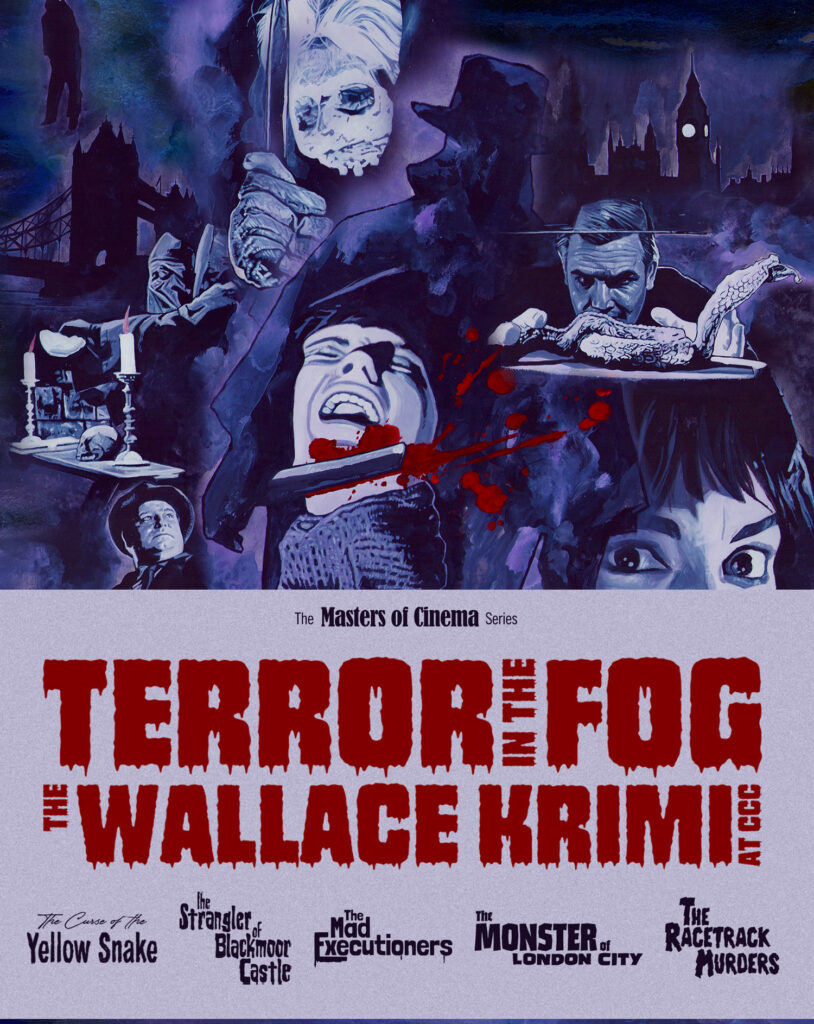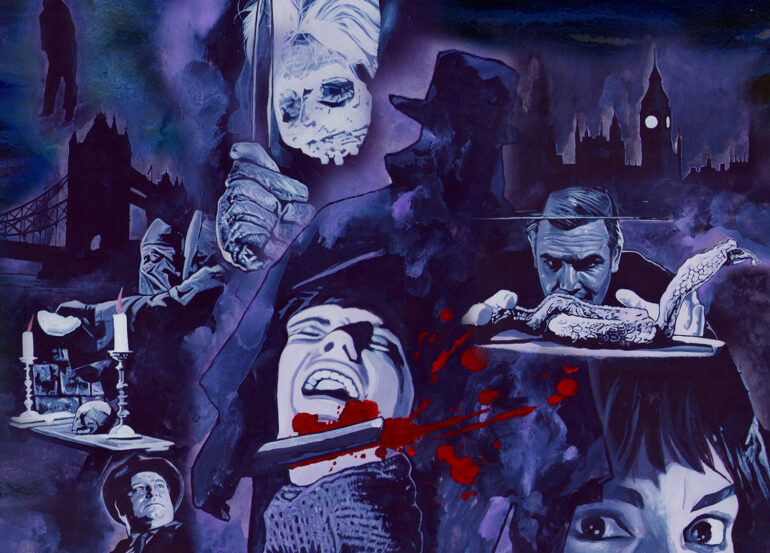Verdict
Summary
Eureka! has just released this five-film collection (limited to 2000 units) they’ve entitled Terror in the Fog: The Wallace Krimi at CCC, and it’s a really solid (literally, as it’s encased in a hardshell box) set for fans of early slashers. I went in having zero expectations and ended up really enjoying these films, and I suspect others will too. The presentations are all really good (aside from The Phantom of SOHO, which is presented in standard definition), and there are tons of bonus materials and a booklet to keep you going for a good long while.
The Curse of the Yellow Snake (1963) Plot:
A cult seeks an artifact they think will usher in a new golden age for China.
Review:
A bachelor and thief named Clifford (Joachim Fuchsberger) steals an ancient coiled snake artifact (apparently, it’s yellow, but you wouldn’t know it because the film is in black and white) from its resting place, and suddenly an intriguing plot begins: A band of Chinese thugs hunts him when they realize that he has the item. He hides it, thinking it’s safe, but danger lurks at every corner, sometimes announcing itself in the form of a hurled dagger or two. Clifford has been summoned by a man who works for him (he’s part owner in a company), and the gentleman in question is deep in debt and needs to raise over 50K or he’ll go to prison. The man offers Clifford a deal that he hopes will boost his income: He has two unmarried daughters, and he’s hoping that Clifford will marry one or the other very quickly so that their two incomes will merge. Clifford takes his pick of the two (he goes with the cute younger one, which would’ve been my pick too because the older daughter is a big sourpuss), but the younger maiden has another suitor in the form of Clifford’s half-brother Fing-Su (Pinkas Braun with painful looking facial pincers to make him look half-Chinese). Fing-Su is the nefarious leader of the cult that has been stalking Clifford, and we see that his plan is to marry into Clifford’s company and therefore have even more influence, but he’s just gotta get his hands on the yellow snake artifact because the foundation of his cult is to (somehow, I’m not really sure how) take over Germany first, and then the world, ushering in a new golden age for China. Clifford, though, is a hero, and with the help of his father, they thwart Fing-Su’s cult just in the nick of time.
From director Franz Joseph Gottleib, the pulpy German mystery / thriller fits right into the Mr. Wong / Fu Manchu franchises with its danger-at-every-corner thrills and spooky tone. It’s fun if you’re in the mood for it, and for this reader of old pulp novels, I’m its audience, no question about it. It’s no especially memorable, but it’s better than many others of its ilk, so that’s a win.
The Strangler of Blackmoor Castle (1963) Plot:
A soon-to-be-knighted aristocrat fends off a masked murderer lurking around his estate.
Review:
An older gentleman invites friends and family to the Blackmoor estate, a sprawling a woodsy hillock with a spacious castle smack in the middle of the gothic ebbs and flows of nature’s generosity. For goodness’ sake, there’s even a swamp nearby! The man in question has much to look forward to: He’s going to be knighted by the Queen, and despite having mounting debts, he vows to pay it all back before he’s granted knighthood. How, one may ask, could a man deep in debt hope to pay off said debts? Priceless, uncut diamonds, of course! He hires a diamond cutter, who gets to work, but the jeweler becomes obsessed with the glittery stones, and strange to say it, but there’s a masked mad prowling around the estate, strangling people close to the castle! The killer’s victims (they begin piling up) have a bloody “M” etched on their foreheads, and did I mention as well that the killer also decapitates his victims after strangling them? Who could do such a thing? Well, I guarantee you we’ll find out! A Scotland Yard detective happens to be on the case (though there seems to be some confusion about the “M” possibly being a “W”), and during his perilous investigation, he falls in love with the soon-to-be-knighted man’s pretty daughter (played by future Bond girl Karin Dor from You only Live Twice), who might be on the killer’s next as one of his victims!
A clear influence on future giallo filmmakers, The Strangler of Blackmoor Castle is pretty darn good with stylish killings galore … the best one involves decapitating a motorcycle rider and then rigging the ground with a pattern of gasoline around the body. The killer’s creep mask is basically a ski mask with perfectly cut slits for the eyes to see through, and the guy is big and imposing and he doesn’t discriminate between men or women, so the guy’s a maniac! From director Harald Reinl, this thriller should more than appeal to fans of horror / slasher films: It should delight them as well!
The Mad Executioners (1963) Plot:
Scotland Yard is flummoxed by a series of separate serial killings in the city: People are found strung up in public, and attractive women are found headless.
Review:
A secret sect of judges convene in a subterranean lair, and they wear black hoods as if they’re executioners, and indeed they are: They pluck out members of society who they’ve deemed undesirable for their crimes and they rush them through a mock trial and thusly hang them in a public place in the middle of the night. Meanwhile, Scotland Yard already ahs their hands full with another crazed killer who chops off women’s heads with surgical precision, leaving the bodies out for anyone to find. What kind of world is this? A set of detectives scramble to figure it all out, and one cop’s pretty daughter (blonde Maria Perschy) allows herself to be bait for the decapitator, and (un)lucky for her, the first guy who hits on her at the carnival is the mad doctor who’s obviously the killer!
The Mad Executioners has an awful lot going on, but thankfully it’s just stylish and involving enough not to go too overboard with its hackneyed plot that seems to cross-pollinate two plots into one messy whodunnit. The climax feels like one of those mad doctor with two brains kinds of horror movies, but a good fistfight between the hero and some intrepid beat cops against the insane doctor cures all ills. It’s goofy, but I liked it, so what are you gonna do about it? Several key cast members here were also in The Strangler of Blackmoor Castle. From director Edwin Zbonek.
The Phantom of SOHO (1964) Plot:
Victims are being stabbed by a masked “phantom” in and around a gentleman’s club in SOHO.
Review:
A trendy gentleman’s club in SOHO run by a disabled woman and her shadowy doctor has become the epicenter of a series of stabbings perpetrated by a “phantom,” or so dubs the media because unreliable witnesses (such as hobos and winos in dark alleys) only see a masked, gloved assailant. A female author with a “can-do” grin and spring in her step asks to be let into the crime scenes to help inspire her next book, and the detectives figure “why not?” and let her get an inside view of the grisly slayings. When the nightclub’s star attraction – a knife thrower – is killed almost literally in front of the police (the lights suddenly go out during his questioning, and when they come back on, he’s got a knife in his heart), the heat is on for the police to come up with some suspects right away or who knows will be next? An investigation reveals that all the victims once shared a voyage together, a ship that sank, and there’s one common denominator: The Phantom of SOHO!
A proto-giallo or slasher if ever there was one, The Phantom of SOHO follows all the tropes of the genre that would follow, complete with a masked / gloved killer and the killer’s POV as they kill, and there’s even a surprising amount of nudity in this one. It’s black and white and filmed in German, but I tell you what – it’s a solid thriller with a twist (I figured out who the killer was fairly early on, but not the motive, which, as it turns out, is pretty sordid for a film made in 1964). Fans of slashers and giallos should add this one to the list to watch! From director Franz Josef Gottlieb.
The Monster of London City (1964) Plot:
A Jack the Ripper copycat is slaying women in London at the same time a popular live play is shattering box office receipts.
Review:
Women of the night (i.e. hookers or sex workers) are being slashed to death in modern-day London with a razor by a man in a black cape and cowl, and the media dubs him Jack the Ripper because he basically follows the methods of the original serial killer we all know and love to hate. Meanwhile, a very popular live production that uses the Ripper’s tale is shattering box office receipts, and the actor who portrayed the Ripper is a well known thespian named Richard Sand (Hansjorg Felmy) who has become weary and depressed at playing this horrible killer night after night. Women in the audience regularly faint with freight at his portrayal, and the critics love his performance, but police have their eye on him as their prime suspect because they literally have no other suspects. With Sand threatening the producers that he’s going to quit soon, they scramble to try to placate him to keep going, but when one of the main actresses in the show becomes the Ripper’s next (real) victim, the media and the cops have a field day in trying to tie Sand to the murder. At the next performance (which is closely monitored by the police), somehow the prop knife Sand always uses is swapped out with a real one, but lucky for him, he drops the knife, which stabs the floor, forcing him to break character and storm off the stage in a rag because if he’d use it like he always does in his performance, someone would surely have been killed mid-performance. So, is Sand the killer? Or is someone trying to set him up?
A really solid slasher / thriller with a surprising amount of gore and nudity for a film shot in ’64, The Monster of London City is yet another very good West German “Krimi” mystery horror film. It keeps you guessing with never a dull moment, filling its less-than-80 minute runtime with kills, thrills, and sexy stuff. Fans of Jack the Ripper movies and stories, and gothic features such as The Phantom of the Opera will get absolutely everything they crave with this one. From director Edwin Zbonek.
The Racetrack Murders (1964) Plot:
Victims stack up in and around a racetrack.
Review:
A big derby is coming up, and when the jockey for a big black stallion named Satan is killed in what seems to be an accident (it’s not – we see saboteurs spook the horse with a huge snake), it’s only the beginning for a series of seven consecutive murders. The very same evening at the derby, a shindig commences with all the hoi polloi, and all of a sudden the trumpet player is shot dead with a single bullet. What the heck is happening here? We later get an inside peek behind the stables, and we learn that a great deal is riding (ha-ha) on the upcoming race, and because Satan is the favored winner by miles, there’s a plot to have the horse injured or drugged so that he loses. The vet is offered a lot of money to make sure that happens, and because he’s a humble man with very little money and because the girl he loves turns his marriage proposal down because he’s basically poor (her rejection is really sad and pathetic), he decides to try to work with the shady guys who want Satan to lose, but this crossing of the moral and legal line puts him smack in the middle of a plot where other people around him are turning up dead. Will he be next?
As a pseudo-slasher / whodunnit, The Racetrack Murders has a refreshing setting for a bunch of killings, each of which is different than the last. There’s an impaling by pitchfork, a drowning, and various others that I haven’t already mentioned, and so the killer – or killers – are indiscriminate in how they dispatch their targets. It’s got some stylish cinematography and a pretty good little plot, but just don’t expect to retain much of it afterwards. From Franz Joseph Gottlieb.
Eureka! has just released this five-film collection (limited to 2000 units) they’ve entitled Terror in the Fog: The Wallace Krimi at CCC, and it’s a really solid (literally, as it’s encased in a hardshell box) set for fans of early slashers. I went in having zero expectations and ended up really enjoying these films, and I suspect others will too. The presentations are all really good (aside from The Phantom of SOHO, which is presented in standard definition), and there are tons of bonus materials and a booklet to keep you going for a good long while.
Bonus Materials
- Limited Edition of 2000 copies
- Limited edition hardbound slipcase featuring new artwork by Poochamin
- Limited edition 60-page collector’s book featuring a new introduction to the Wallace krimi cycle by film writer Howard Hughes, a new essay on Edgar Wallace and Bryan Edgar Wallace by crime fiction expert Barry Forshaw and new notes on each film by Holger
- All five films presented in 1080p HD from 2K restorations of the original film elements undertaken by CCC Film
- The Phantom of Soho (Franz Josef Gottlieb, 1964) – bonus feature (presented in SD)
- Optional English subtitles, newly revised for this release
- Optional English dubs for The Strangler of Blackmoor Castle, The Mad Executioners, The Monster of London City and The Phantom of Soho
- New introductions to each film by genre film expert and Video Watchdog founder Tim Lucas
- New audio commentaries on The Curse of the Yellow Snake and The Phantom of Soho by Kim Newman and Barry Forshaw
- New audio commentaries on The Strangler of Blackmoor Castle, The Mad Executioners and The Racetrack Murders by Kevin Lyons and Jonathan Rigby
- New audio commentary on The Monster of London City by Kim Newman and Stephen Jones
- Bryan Edgar Wallace: An Era – new interview with Alice Brauner, producer and managing director of CCC Film and daughter of Artur Brauner
- Passing the Blade – new video essay by Alexandra Heller-Nicholas exploring the influence of the Wallace krimi on the Italian giallo and American slasher film



